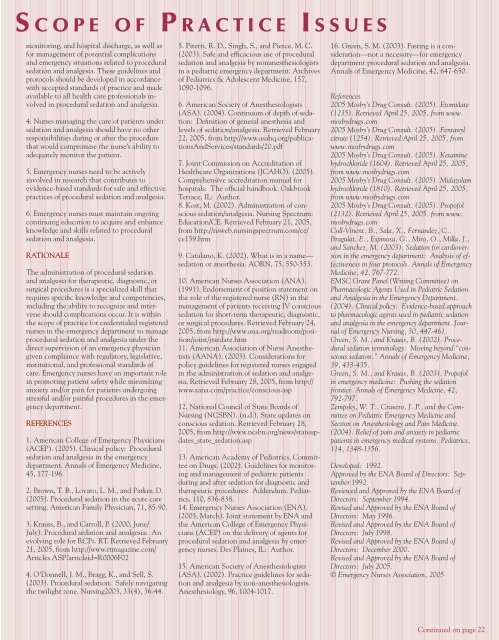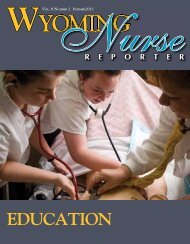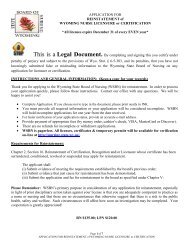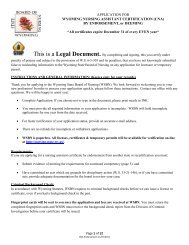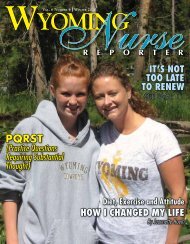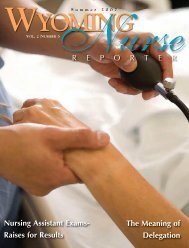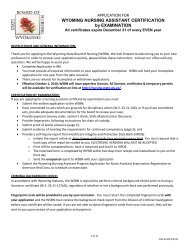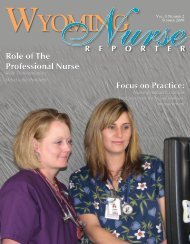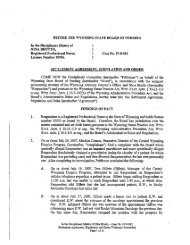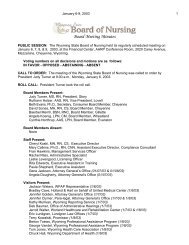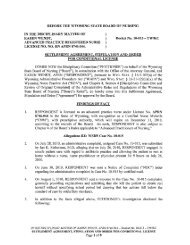S c o p e o f Pr a c t i c e Is s u e sEmergency nurses are increasingly involved inthe administration and monitoring <strong>of</strong> sedation,with or without analgesia, for many emergentand urgent procedures in the emergencydepartment. Common conditions that call forprocedural sedation include those that necessitatepain and/or anxiety control to successfullyadminister therapeutic, diagnostic, or surgicalprocedures (e.g., bone fracture reduction,laceration repair, and burn debridement).1-5Procedural sedation also may be <strong>of</strong> benefit topatients, such as children and mentally challengedadults, who experience extreme anxietyor behavioral upset during procedures thatrequire them to remain still (e.g., diagnosticimaging for children).2-4According to the American College <strong>of</strong> EmergencyPhysicians (ACEP), procedural sedationis defined as “a technique <strong>of</strong> administeringsedatives or dissociative agents with or withoutanalgesics to induce a state that allows thepatient to tolerate unpleasant procedures whilemaintaining cardiorespiratory function.”1 Thelevels <strong>of</strong> sedation are classified as:3,6,7• Minimal sedation (anxiolysis): A medication-inducedstate during which cognitivefunction and coordination may be impaired butcardiovascular and ventilatory functions remainunaffected.• Moderate sedation/analgesia (formerly called“conscious sedation”): A medication-induceddepression <strong>of</strong> consciousness during whichpatients can respond purposefully to verbalcommands and independently maintain acontinuous airway. Cardiovascular function isusually maintained and spontaneous ventilationis adequate.• Deep sedation/analgesia: A medicationinduceddepression <strong>of</strong> consciousness duringwhich patients cannot be easily awakenedbut can respond purposefully after repeated orpainful stimulation. Cardiovascular function isusually maintained, but spontaneous ventilationmay not be adequate and airway patencymay require assistance.• General anesthesia: A medication-inducedloss <strong>of</strong> consciousness during which patients cannotbe aroused, even with painful stimulation.Cardiovascular function may be impaired, spontaneousventilation is frequently inadequate,and assistance is usually required to maintainairway patency.The various levels <strong>of</strong> sedation comprise a continuum,and because it is not always possible topredict how each patient will respond, patientsmay abruptly enter into a deeper level <strong>of</strong> sedationthan intended.6 For this reason, healthcare providers who administer and monitorprocedural sedation should be pr<strong>of</strong>icient inairway management and cardiovascular supportto rescue patients who enter into a deeper level,for example, from moderate sedation into deepsedation.1,2,7 In addition, complications mayarise during the procedure such as vomiting,respiratory depression and loss <strong>of</strong> protectiveairway reflexes, hypoxia, hypotension, allergicreaction, and cardiac arrest.1,2,8 Institutionalpolicy may require providers to be trained inbasic cardiac life support (BCLS), advancedcardiac life support (ACLS), and if appropriate,pediatric advanced life support (PALS) inorder to administer procedural sedation andanalgesia.4,9Compliance with regulatory, statutory, andpr<strong>of</strong>essional standards <strong>of</strong> care for the administration<strong>of</strong> procedural sedation and analgesiais necessary to ensure patient safety.4,8-10 Forinstance, the Joint Commission on Accreditation<strong>of</strong> Healthcare Organizations (JCAHO)outlines sedation and anesthesia standardsthat include a requirement for qualified andcompetent individuals to perform proceduralsedation.7,9 These qualified individuals mustbe able to perform rescues outlined in the standardsand manage the patient at whatever level<strong>of</strong> sedation and analgesia is achieved.7 If statelaw and institutional policy permit, registerednurses can administer some forms <strong>of</strong> proceduralsedation and analgesia.4,10-12 According tothe American <strong>Nurse</strong>s Association (ANA), itis within the scope <strong>of</strong> practice for a registerednurse to administer medications and managepatient care for patients receiving minimal ormoderate sedation/analgesia.10Procedural sedation and analgesia involvesthe use <strong>of</strong> pharmacological agents that maybe administered by different routes includingintravenous, intramuscular, inhalation, nasal,oral, and rectal administration.13 ENA andACEP support the delivery <strong>of</strong> medicationsused for procedural sedation and analgesia bycredentialed emergency nurses working underthe direct supervision <strong>of</strong> an emergency physician.These agents include but are not limitedto etomidate, prop<strong>of</strong>ol, ketamine, fentanyl, andmidazolam.14 Many hospitals require nurses tocomplete an educational program and demonstratethe competencies necessary to administerand manage procedural sedation and analgesia.11Programs may include instruction in thepharmacology <strong>of</strong> drugs used for procedural sedationand analgesia, supervised clinical exercisesin upper airway management and resuscitation,and a competency exam.1,4,15The process <strong>of</strong> procedural sedation and analgesiabegins with a patient evaluation involvinga physical examination as well as a medicalhistory that covers previous adverse experienceswith sedation/analgesia and time and nature <strong>of</strong>last oral intake.1,15 The American Society <strong>of</strong>Anesthesiologists (ASA) recommends a sixhourfast for food and a two-hour fast for clearliquids before procedural sedation; however,these guidelines may not always be possible inthe emergency care setting.2,15,16Prior to the procedure, the patient shouldreceive counseling regarding risks, benefits,and alternatives to sedation and analgesia.1,15In addition, protocols and appropriately-sizedequipment for both pediatric and adult patientsshould be readily available and in place so thatthe patient’s condition can be monitored andpossible complications managed throughout theprocess. Appropriate equipment includes oxygen,suction, and advance life support equipmentsuch as medications, a bag-valve-maskdevice, and intubation equipment.1,15Patients undergoing sedation and analgesiarequire frequent assessments <strong>of</strong> their vital signs,such as heart rate, blood pressure, respiratoryrate, and pulse oximetry; cardiopulmonarystatus including cardiac monitoring, breathsounds, skin color, oxygen saturation, andexhaled carbon dioxide; and level <strong>of</strong> consciousness(e.g., ability for patient to respond toverbal commands).1 Monitoring and documentation<strong>of</strong> vital signs should occur before, during,and after procedural sedation and analgesia.1The registered nurse who monitors the patientshould have no other duties to perform duringthe sedation and recovery process.1,10,15Monitoring should continue post-procedureuntil the patient returns to his or her baselinelevel <strong>of</strong> function and is ready for discharge.2,8The ANA recommends that registered nurseswho administer and monitor procedural sedationand analgesia be able to: (a) identify anddifferentiate the various levels <strong>of</strong> sedation;(b) demonstrate the acquired knowledge <strong>of</strong>anatomy, physiology, pharmacology, cardiacdysrhythmia recognition, and complicationsrelated to procedural sedation and analgesia;(c) demonstrate competence in pre-procedural,procedural, and post-procedural nursing carefrom the initial patient evaluation to patientdischarge; (d) anticipate, recognize, and addresspotential complications during the process;and (e) understand the medical/legal aspects <strong>of</strong>procedural sedation and analgesia.8,10ASSOCIATION POSITIONIt is the position <strong>of</strong> ENA that:1. It is within the scope <strong>of</strong> practice for aninstitutionally-credentialed registered nurseworking in the emergency department to delivermedications used for procedural sedationand analgesia under the direct supervision <strong>of</strong> anemergency physician.2. Health care organizations should haveeducational and credentialing mechanisms inplace that include a process for evaluating anddocumenting the registered nurse’s knowledge,skills, and abilities related to the management<strong>of</strong> patients receiving procedural sedation andanalgesia. Evaluation and documentation <strong>of</strong>competency should occur on a periodic basisaccording to institutional policy.3. Health care organizations should involvenurses in the development <strong>of</strong> guidelines andprotocols for drug administration, patient
S c o p e o f Pr a c t i c e Is s u e smonitoring, and hospital discharge, as well asfor management <strong>of</strong> potential complicationsand emergency situations related to proceduralsedation and analgesia. These guidelines andprotocols should be developed in accordancewith accepted standards <strong>of</strong> practice and madeavailable to all health care pr<strong>of</strong>essionals involvedin procedural sedation and analgesia.4. <strong>Nurse</strong>s managing the care <strong>of</strong> patients undersedation and analgesia should have no otherresponsibilities during or after the procedurethat would compromise the nurse’s ability toadequately monitor the patient.5. Emergency nurses need to be activelyinvolved in research that contributes toevidence-based standards for safe and effectivepractices <strong>of</strong> procedural sedation and analgesia.6. Emergency nurses must maintain ongoingcontinuing education to acquire and enhanceknowledge and skills related to proceduralsedation and analgesia.RATIONALEThe administration <strong>of</strong> procedural sedationand analgesia for therapeutic, diagnostic, orsurgical procedures is a specialized skill thatrequires specific knowledge and competencies,including the ability to recognize and interveneshould complications occur. It is withinthe scope <strong>of</strong> practice for credentialed registerednurses in the emergency department to manageprocedural sedation and analgesia under thedirect supervision <strong>of</strong> an emergency physiciangiven compliance with regulatory, legislative,institutional, and pr<strong>of</strong>essional standards <strong>of</strong>care. Emergency nurses have an important rolein promoting patient safety while minimizinganxiety and/or pain for patients undergoingstressful and/or painful procedures in the emergencydepartment.REFERENCES1. American College <strong>of</strong> Emergency Physicians(ACEP). (2005). Clinical policy: Proceduralsedation and analgesia in the emergencydepartment. Annals <strong>of</strong> Emergency Medicine,45, 177-196.2. Brown, T. B., Lovato, L. M., and Parker, D.(2005). Procedural sedation in the acute caresetting. American Family Physician, 71, 85-90.3. Krauss, B., and Carroll, P. (2000, June/July). Procedural sedation and analgesia: Anevolving role for RCPs. RT. Retrieved February21, 2005, from http://www.rtmagazine.com/Articles.ASP?articleid=R0006F024. O’Donnell, J. M., Bragg, K., and Sell, S.(2003). Procedural sedation: Safely navigatingthe twilight zone. <strong>Nursing</strong>2003, 33(4), 36-44.5. Pitetti, R. D., Singh, S., and Pierce, M. C.(2003). Safe and efficacious use <strong>of</strong> proceduralsedation and analgesia by nonanesthesiologistsin a pediatric emergency department. Archives<strong>of</strong> Pediatrics & Adolescent Medicine, 157,1090-1096.6. American Society <strong>of</strong> Anesthesiologists(ASA). (2004). Continuum <strong>of</strong> depth <strong>of</strong> sedation:Definition <strong>of</strong> general anesthesia andlevels <strong>of</strong> sedation/analgesia. Retrieved February22, 2005, from http://www.asahq.org/publicationsAndServices/standards/20.pdf7. Joint Commission on Accreditation <strong>of</strong>Healthcare Organizations (JCAHO). (2005).Comprehensive accreditation manual forhospitals: The <strong>of</strong>ficial handbook. OakbrookTerrace, IL: Author.8. Kost, M. (2002). Administration <strong>of</strong> conscioussedation/analgesia. <strong>Nursing</strong> Spectrum:Education/CE. Retrieved February 21, 2005,from http://nsweb.nursingspectrum.com/ce/ce159.htm9. Catalano, K. (2002). What is in a name—sedation or anesthesia. AORN, 75, 550-553.10. American <strong>Nurse</strong>s Association (ANA).(1991). Endorsement <strong>of</strong> position statement onthe role <strong>of</strong> the registered nurse (RN) in themanagement <strong>of</strong> patients receiving IV conscioussedation for short-term therapeutic, diagnostic,or surgical procedures. Retrieved February 24,2005, from http://www.ana.org/readroom/position/joint/jtsedate.htm11. American Association <strong>of</strong> <strong>Nurse</strong> Anesthetists(AANA). (2003). Considerations forpolicy guidelines for registered nurses engagedin the administration <strong>of</strong> sedation and analgesia.Retrieved February 28, 2005, from http://www.aana.com/practice/conscious.asp12. National Council <strong>of</strong> <strong>State</strong> <strong>Board</strong>s <strong>of</strong><strong>Nursing</strong> (NCSBN). (n.d.). <strong>State</strong> updates onconscious sedation. Retrieved February 28,2005, from http://www.ncsbn.org/news/stateupdates_state_sedation.asp13. American Academy <strong>of</strong> Pediatrics, Committeeon Drugs. (2002). Guidelines for monitoringand management <strong>of</strong> pediatric patientsduring and after sedation for diagnostic andtherapeutic procedures: Addendum. Pediatrics,110, 836-838.14. Emergency <strong>Nurse</strong>s Association (ENA).(2005, March). Joint statement by ENA andthe American College <strong>of</strong> Emergency Physicians(ACEP) on the delivery <strong>of</strong> agents forprocedural sedation and analgesia by emergencynurses. Des Plaines, IL: Author.15. American Society <strong>of</strong> Anesthesiologists(ASA). (2002). Practice guidelines for sedationand analgesia by non-anesthesiologists.Anesthesiology, 96, 1004-1017.16. Green, S. M. (2003). Fasting is a consideration—nota necessity—for emergencydepartment procedural sedation and analgesia.Annals <strong>of</strong> Emergency Medicine, 42, 647-650.References2005 Mosby’s Drug Consult. (2005). Etomidate(1235). Retrieved April 25, 2005, from www.mosbydrugs.com2005 Mosby’s Drug Consult. (2005). Fentanylcitrate (1254). Retrieved April 25, 2005, fromwww.mosbydrugs.com2005 Mosby’s Drug Consult. (2005). Ketaminehydrochloride (1604). Retrieved April 25, 2005,from www.mosbydrugs.com2005 Mosby’s Drug Consult. (2005). Midazolamhydrochloride (1810). Retrieved April 25, 2005,from www.mosbydrugs.com2005 Mosby’s Drug Consult. (2005). Prop<strong>of</strong>ol(2132). Retrieved April 25, 2005, from www.mosbydrugs.comColl-Vinent, B., Sala, X., Fernandez, C.,Bragulat, E., Espinosa, G., Miro, O., Milla, J.,and Sanchez, M. (2003). Sedation for cardioversionin the emergency department: Analysis <strong>of</strong> effectivenessin four protocols. Annals <strong>of</strong> EmergencyMedicine, 42, 767-772.EMSC Grant Panel (Writing Committee) onPharmacologic Agents Used in Pediatric Sedationand Analgesia in the Emergency Department.(2004). Clinical policy: Evidence-based approachto pharmacologic agents used in pediatric sedationand analgesia in the emergency department. Journal<strong>of</strong> Emergency <strong>Nursing</strong>, 30, 447-461.Green, S. M., and Krauss, B. (2002). Proceduralsedation terminology: Moving beyond “conscioussedation.” Annals <strong>of</strong> Emergency Medicine,39, 433-435.Green, S. M., and Krauss, B. (2003). Prop<strong>of</strong>olin emergency medicine: Pushing the sedationfrontier. Annals <strong>of</strong> Emergency Medicine, 42,792-797.Zempsky, W. T., Cravero, J. P., and the Committeeon Pediatric Emergency Medicine andSection on Anesthesiology and Pain Medicine.(2004). Relief <strong>of</strong> pain and anxiety in pediatricpatients in emergency medical systems. Pediatrics,114, 1348-1356.Developed: 1992.Approved by the ENA <strong>Board</strong> <strong>of</strong> Directors: September1992.Reviewed and Approved by the ENA <strong>Board</strong> <strong>of</strong>Directors: September 1994.Revised and Approved by the ENA <strong>Board</strong> <strong>of</strong>Directors: May 1996.Revised and Approved by the ENA <strong>Board</strong> <strong>of</strong>Directors: July 1998.Revised and Approved by the ENA <strong>Board</strong> <strong>of</strong>Directors: December 2000.Revised and Approved by the ENA <strong>Board</strong> <strong>of</strong>Directors: July 2005.© Emergency <strong>Nurse</strong>s Association, 2005Continued on page 22


